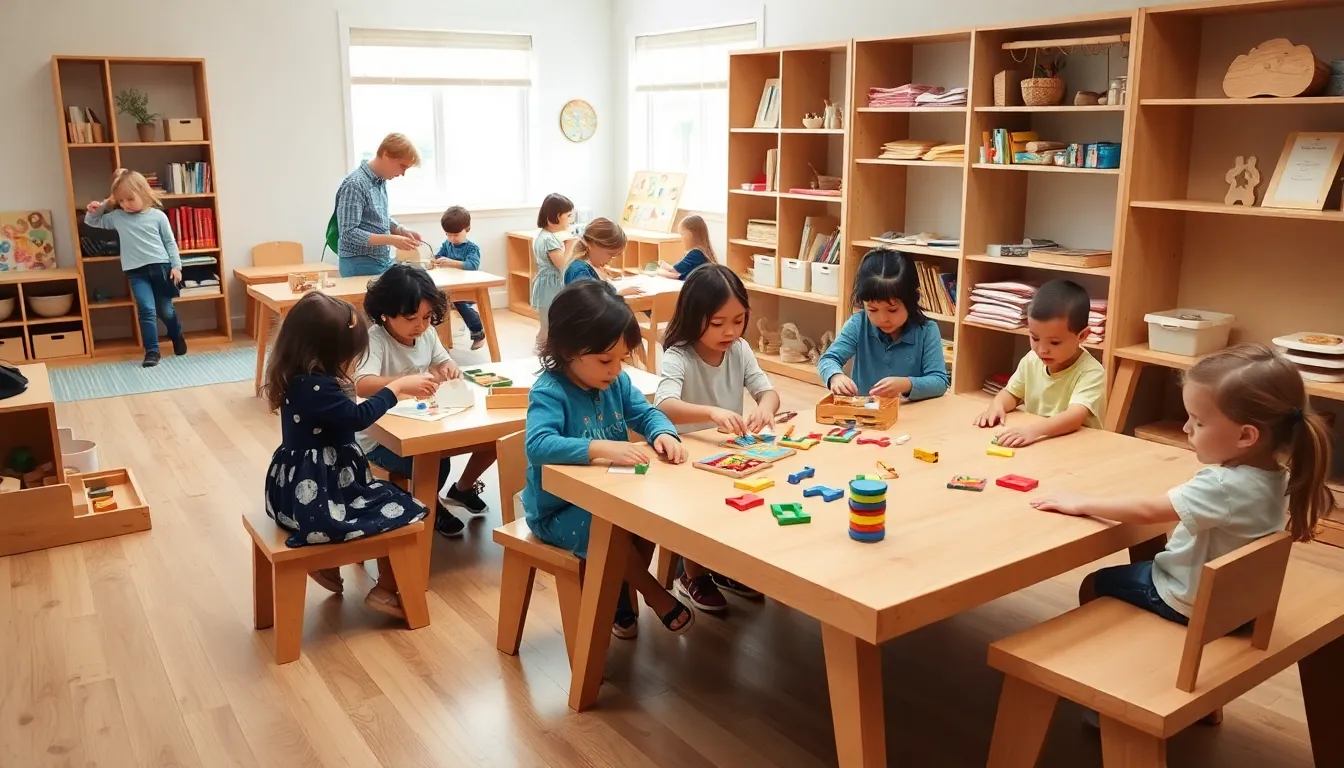If you’ve ever watched children play, you might have noticed how magically they engage with the world around them. Montessori play takes this natural curiosity and amplifies it into a powerful educational tool. Picture a room filled with beautifully crafted toys, each designed to stimulate the intellect and creativity of little ones. That’s Montessori play for you. It’s not just about making noise or having fun. Instead, it’s a structured approach that encourages independence and self-discovery. In this guide, uncover the principles of Montessori play, its importance, and how to create an enriching environment to nurture young minds. Prepare to embrace a world where learning and play collide.
Table of Contents
ToggleUnderstanding Montessori Play Principles

Montessori play is built on a foundation of several key principles that guide children’s learning. At its core, this approach encourages exploration, independence, and hands-on experiences. Each child is viewed as an active participant in their education, rather than a passive receiver of information. This active learning fosters curiosity and motivation.
For instance, the prepared environment is central to Montessori play. It refers to spaces designed specifically to meet the developmental needs of children. By offering age-appropriate materials, children can choose activities that resonate with them, engage deeply, and learn at their own pace.
Also, the concept of freedom within limits is essential. Children are given the autonomy to select activities, but within a framework that ensures safety and respect for others. This balance cultivates essential life skills.
Summarizing, Montessori play principles empower children by fostering independence, exploration, and purposeful engagement with their learning environment.
The Importance of Play in Montessori Education
Play holds a vital role in Montessori education. It is through play that children develop essential skills such as social interaction, problem-solving, and fine motor abilities. Recognizing this, Montessori educators embrace play as a legitimate form of learning.
Research consistently shows that children learn best when they are actively engaged. Play provides the perfect backdrop for this to occur. During playtime, children practice cooperation and communication, learn to negotiate, and handle conflicts, skills that will serve them well throughout their lives.
Also, play allows for the exploration of concepts in a tangible way. By manipulating objects, children can grasp abstract ideas, such as gravity or balance, through firsthand experience. This experiential learning is far more impactful than rote memorization.
In essence, Montessori play is not just a break from learning: it is integral to development, fostering a holistic approach to education.
Types of Montessori Play Activities
Montessori play activities are diverse and designed to cater to different interests and developmental stages. Here are several types you might encounter:
Practical Life Activities
These activities focus on daily living skills. Children might practice pouring water, tying shoelaces, or setting the table. Such tasks not only build independence but also enhance fine motor skills.
Sensorial Activities
Designed to refine the senses, these activities could involve sorting materials by size, color, or texture. They help children categorize and make sense of their experiences.
Language Activities
These encourage literacy through storytelling, matching words to pictures, or engaging in phonetic games. Language development is interwoven with play, ensuring children enjoy the journey to literacy.
Mathematics Activities
Hands-on math materials like counting beads or number rods make abstract concepts tangible. Children can visually and physically manipulate materials, helping solidify their understanding.
Each type of activity plays a specific role in nurturing a child’s development, ensuring a well-rounded educational experience.
Creating a Montessori Play Environment
Creating a Montessori play environment involves careful thought and intentional design. Here are some essential elements to consider:
Simplicity
A clutter-free environment allows children to focus. Select a few high-quality materials and rotate them periodically to maintain interest and promote exploration.
Accessibility
Everything in a Montessori environment should be within reach of children. This empowers them to make choices and fosters independence. Low shelves and child-sized furniture invite self-directed learning.
Natural Materials
Wood, metal, and fabric are preferable to plastic. Natural materials are often more appealing to children and promote a sense of calm in the environment. This aligns well with the Montessori philosophy of respecting nature.
Designated Areas
Create distinct areas for different types of play, like a reading nook, a sensory area, or a practical life corner. Clear zones guide children in their activities and ensure they can engage meaningfully.
By thoughtfully designing a play environment, caregivers can support the principles of Montessori education and enhance children’s learning experiences.
Role of the Guide in Montessori Play
In Montessori play, the role of the guide is crucial. Unlike traditional educators, Montessori guides adopt a more observational role. They interact less directly, instead allowing children the freedom to discover and experiment.
The guide prepares the environment, providing materials that inspire exploration. They observe children’s interests and skills, stepping in only when necessary to offer support or new insights. This respects each child’s unique learning journey.
Guides also encourage a culture of respect and collaboration. By modeling appropriate behavior, they instill values of kindness and empathy. They’re there to help discussions, prompting children to think critically and reflect on their experiences.
Eventually, the guide serves as a bridge between the child and the rich world of learning opportunities, allowing children to engage meaningfully with their environment.
Integrating Montessori Play at Home
Integrating Montessori play into the home can be both simple and rewarding. Start by creating a cozy and organized play space. Stock it with open-ended materials, blocks, nature items, or art supplies, that promote creativity.
Encourage daily routines that incorporate practical life skills. Simple tasks like preparing meals together or gardening provide rich learning experiences. Children can engage hands-on, exploring cause and effect, responsibility, and task completion.
Plus, help outdoor play. Nature offers countless opportunities for exploration and discovery. A walk in the park or time in the garden allows children to connect with their environment firsthand.
Finally, encourage independent play. Allow children time to explore and play without constant adult intervention. This autonomy fosters confidence and self-reliance.
Implementing Montessori principles at home helps children thrive, reinforcing the idea that learning can happen anywhere.


